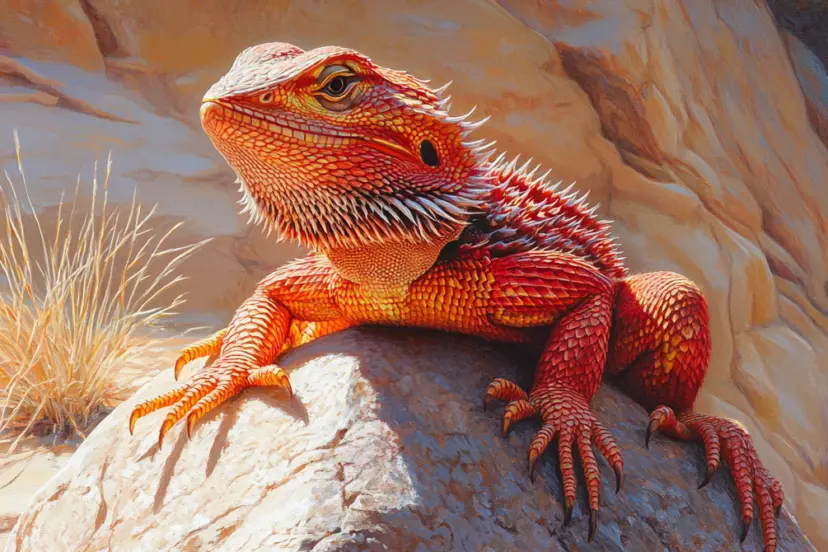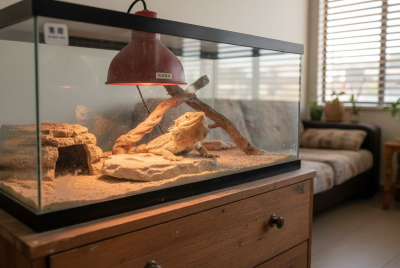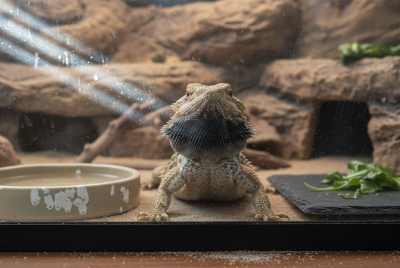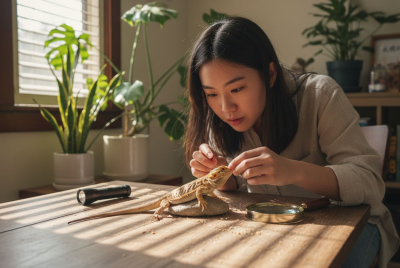Red Bearded Dragon: Care Guide for This Stunning Morph
Bearded dragons are known for their calm temperament, and the Red Bearded Dragon morph adds a stunning splash of color to their already captivating appearance. Whether you’re a first-time reptile owner or a seasoned enthusiast, caring for a Red Bearded Dragon comes with its own set of needs. In this guide, I’ll walk you through everything you need to know, from their diet to breeding tips, and how to keep your dragon healthy and happy.
What Makes the Red Bearded Dragon Special?
The Red Bearded Dragon is not a separate species but a beautiful color variation, or morph, of the common Bearded Dragon (Pogona vitticeps). These dragons have been selectively bred for their brilliant red tones, which can range from light oranges and reds to deep crimson hues. While they share the same care needs as other bearded dragons, their striking appearance sets them apart.
The Genetics Behind Red Bearded Dragons
Red Bearded Dragons owe their unique color to selective breeding practices aimed at enhancing and intensifying red pigmentation. But did you know there are several variations of the red morph?
Red Morph Variations
There are a few common red morphs, such as the Red Hypo and Blood Red, each with varying intensities of red. These morphs can be combined with other traits like hypo (which reduces dark pigmentation) to create even more vibrant appearances.
Selective Breeding and Color Enhancement
Selective breeding has made it possible to emphasize and intensify the reds in these dragons. Breeders pair dragons with the most vibrant colors to produce offspring with enhanced red hues. As a result, Red Bearded Dragons have become some of the most sought-after morphs in the reptile world.
Appearance and Characteristics of Red Bearded Dragons
Red Bearded Dragons have similar physical characteristics to other bearded dragons, with their color being their defining trait. But there are some differences you may notice.
Size and Physical Traits
Like other bearded dragons, Red Bearded Dragons can grow up to 18-24 inches in length, with males typically being slightly larger than females. They have a broad, triangular head, spiny scales along their sides, and a stout body.
Color Intensity: From Light Reds to Deep Crimson
The most striking feature of Red Bearded Dragons is their vibrant coloration. The color intensity can vary greatly depending on the dragon’s genetics, with some displaying a light orange-red and others a dark, almost blood-red hue. Their coloration may also change slightly depending on their mood or temperature, becoming more vibrant when they’re basking under heat lamps.
Setting Up the Ideal Habitat for a Red Bearded Dragon
Caring for a Red Bearded Dragon means providing an optimal habitat that mimics their natural environment. Here’s what you need to know.
Tank Size and Environment
Your Red Bearded Dragon will need plenty of space to thrive. A minimum of a 40-gallon tank is recommended for juveniles, but adults should have at least a 75-100 gallon tank. Ensure the enclosure has a secure mesh lid for proper ventilation.
Temperature and Lighting Requirements
Bearded dragons are cold-blooded, so you’ll need to create a temperature gradient within the tank. The basking spot should reach around 95-105°F for adults, while juveniles require temperatures closer to 110°F. The cooler side of the tank should remain at around 75-85°F. Proper UVB lighting is essential to help your dragon metabolize calcium and maintain bone health.
Choosing the Right Substrate
When it comes to substrate, avoid using loose materials like sand, which can cause impaction if ingested. Instead, opt for safer options like reptile carpet, paper towels, or slate tiles. These substrates are easy to clean and reduce the risk of digestive blockages.
Feeding Your Red Bearded Dragon: What They Need
Feeding a Red Bearded Dragon is similar to feeding any other bearded dragon, but it’s important to balance their diet for proper growth and health.
Insect-Heavy Diet for Juveniles
Juvenile Red Bearded Dragons need a protein-rich diet. Offer them small, gut-loaded insects like crickets, dubia roaches, or mealworms. Juveniles should be fed 2-3 times a day, with insects making up about 70-80% of their diet.
Introducing Greens and Vegetables
As your dragon matures, their diet will shift to be more vegetable-heavy. Adults should eat mostly leafy greens like collard greens, dandelion greens, and mustard greens, alongside a small portion of insects. You can also introduce other vegetables like squash and carrots for variety.
Supplements: Calcium and Vitamins
To prevent health issues like metabolic bone disease, it’s essential to dust your dragon’s food with calcium supplements (with vitamin D3) a few times a week. You should also include a multivitamin once a week to ensure they’re getting all the necessary nutrients.
Common Health Concerns for Red Bearded Dragons
Red Bearded Dragons are generally hardy, but there are a few health issues you should be aware of.
Metabolic Bone Disease: Prevention and Treatment
This is one of the most common health issues in bearded dragons, caused by a lack of calcium or insufficient UVB exposure. Symptoms include lethargy, swollen limbs, and difficulty moving. Prevent this by providing adequate UVB light and calcium-rich food.
Parasites and Dehydration
Bearded dragons are prone to internal parasites, especially if their habitat isn’t properly cleaned. Signs include diarrhea, weight loss, and lack of appetite. Dehydration is also common but can be prevented by misting their vegetables and providing a shallow water dish.
Handling and Socializing Your Red Bearded Dragon
Red Bearded Dragons are usually calm and docile, but proper handling is key to building trust.
Best Practices for Handling
Always handle your dragon gently, supporting their entire body. Start by handling them for 5-10 minutes a day and gradually increase the duration as they become more comfortable. Avoid sudden movements or grabbing them from above, as this can stress them out.
Building Trust and Reducing Stress
To reduce stress, give your dragon time to get used to your presence. Spend time near their tank, talk to them softly, and handle them in short, positive sessions. Over time, they’ll associate you with safety and comfort.
Shedding in Red Bearded Dragons
Like all reptiles, Red Bearded Dragons shed their skin as they grow. However, their vibrant colors can make shedding more noticeable.
Why Red Dragons May Shed More Frequently
Juveniles shed more frequently due to their rapid growth—sometimes as often as every few weeks. Adults will shed less often, but regular shedding is still a sign of healthy growth.
Helping Your Dragon Through Shedding
Provide warm baths and ensure proper humidity levels in the tank during shedding to help loosen the skin. If your dragon has trouble shedding, you can gently rub the stuck areas with a damp cloth.
Personality and Temperament of Red Bearded Dragons
Red Bearded Dragons, like other morphs, have their own personalities, and while their color might make them stand out, their behavior is typically similar to other bearded dragons.
Are They More Aggressive or Docile?
Red Bearded Dragons are generally as docile and friendly as other bearded dragons. They make excellent pets for reptile enthusiasts of all levels because of their calm demeanor. While males can become territorial during mating season, most Red Bearded Dragons are laid-back and enjoy interacting with their owners.
Best Practices for Socialization
The key to having a well-socialized Red Bearded Dragon is early, consistent handling. Start by handling your dragon gently for short periods, gradually increasing the duration. With time, they’ll learn to trust you and will become more comfortable being held and interacted with.
Breeding Red Bearded Dragons: What to Know
Breeding Red Bearded Dragons can be exciting but requires knowledge of genetics and careful planning to ensure healthy offspring and vibrant colors.
Morph Compatibility and Traits
When breeding Red Bearded Dragons, it’s essential to consider morph compatibility. Breeding two red dragons can increase the chances of getting more vibrant red offspring. However, mixing other morphs, like leatherbacks or hypomelanistic (hypo) dragons, can produce interesting combinations that further enhance the color.
Breeding for Vibrant Colors
To breed dragons with the most intense red hues, it’s important to select dragons with strong red pigmentation. These traits are passed down through generations, so breeders often select the brightest red dragons to pair, producing offspring with even more intense colorations.
Conclusion: Caring for Your Red Bearded Dragon
Owning a Red Bearded Dragon is a rewarding experience. Their striking appearance combined with their calm temperament makes them a favorite among reptile enthusiasts. By providing the right care—from a proper habitat and balanced diet to handling and health monitoring—you can ensure your Red Bearded Dragon thrives. Remember, whether you’re a first-time owner or a seasoned dragon enthusiast, these incredible creatures require your dedication and attention, but they’ll reward you with years of companionship.
FAQs
- What makes a Red Bearded Dragon different from other morphs?
The primary difference is their vibrant red coloration, which comes from selective breeding. Otherwise, they share the same care requirements as other bearded dragons. - How often should I feed my Red Bearded Dragon?
Juveniles should be fed 2-3 times a day, primarily insects. Adults should be fed once a day, focusing on vegetables with occasional insects. - Do Red Bearded Dragons require special lighting?
No, Red Bearded Dragons need the same UVB lighting and heat as other bearded dragons. A UVB bulb and a basking spot of 95-105°F are essential. - How can I help my Red Bearded Dragon during shedding?
Provide warm baths and ensure adequate humidity. You can also gently rub any stuck shed with a damp cloth to help them shed more easily. - Can I breed my Red Bearded Dragon with other morphs?
Yes, you can breed Red Bearded Dragons with other morphs, but for the most vibrant red offspring, it’s best to pair them with other red dragons or compatible morphs.
By following these care tips and understanding the unique traits of Red Bearded Dragons, you can ensure a long, healthy life for your pet while enjoying their stunning beauty!




